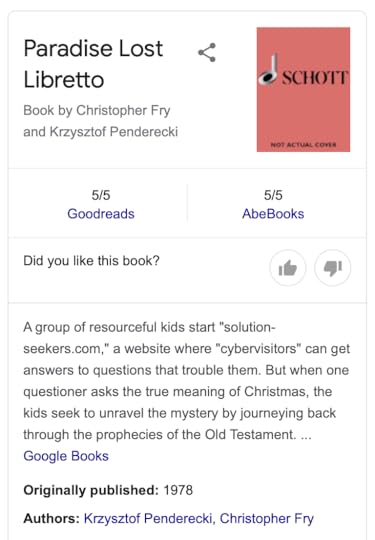Alan Jacobs's Blog, page 155
September 3, 2021
Well now, this is a more innovative adaptation than I tho...

Well now, this is a more innovative adaptation than I thought it would be. As I said, research is fun!
Research is fun.
September 1, 2021
afterwards
This lovely post by my friend Wesley Hill on carrying and using a Bible reminds me of a question I ask myself on a regular basis: What is Christianity when it is no longer a religion of the book? Because I think Christianity around the world, for varying reasons, is becoming and in some places has already fully become a post-book practice. I don’t think we Christians have reckoned as seriously as we ought to with that change — and especially how those of us who remain People of the Book are best to relate to and connect with those whose Christian faith doesn’t employ books.
Elon’s plan
Musk owns Tesla Energy. And I think he’s going to turn a profit on Starship by using it to launch Space based solar power satellites. By my back of the envelope calculation, a Starship can put roughly 5-10MW of space-rate photovoltaic cells into orbit in one shot. ROSA—Roll Out Solar Arrays now installed on the ISS are ridiculously light by historic standards, and flexible: they can be rolled up for launch, then unrolled on orbit. Current ROSA panels have a mass of 325kg and three pairs provide 120kW of power to the ISS: 2 tonnes for 120KW suggests that a 100 tonne Starship payload could produce 6MW using current generation panels, and I suspect a lot of that weight is structural overhead. The PV material used in ROSA reportedly weighs a mere 50 grams per square metre, comparable to lightweight laser printer paper, so a payload of pure PV material could have an area of up to 20 million square metres. At 100 watts of usable sunlight per square metre at Earth’s orbit, that translates to 2GW. So Starship is definitely getting into the payload ball-park we’d need to make orbital SBSP stations practical. 1970s proposals foundered on the costs of the Space Shuttle, which was billed as offering $300/lb launch costs (a sad and pathetic joke), but Musk is selling Starship as a $2M/launch system, which works out at $20/kg.
So: disruptive launch system meets disruptive power technology, and if Tesla Energy isn’t currently brainstorming how to build lightweight space-rated PV sheeting in gigawatt-up quantities I’ll eat my hat.
August 31, 2021
partisan
If you could draw a Venn diagram between those who believed, in turn, that 1) COVID was basically the flu; 2) mandatory masking and social distancing represented ineffective acts of government tyranny; 3) the election was stolen; 4) vaccines are experimental “gene therapies” at best and an outright threat to public health at worst, and 5) the real treatment for COVID is hydroxychloroquine or Ivermectin, there would be a high, high degree of overlap.
In fact, in my experience, belief in any one of those items almost always implies a belief in most if not all the rest….
When I speak to college students, one of the first things I say is that they should do their best to avoid the “partisan mind.” I don’t mean they should avoid voting for partisan candidates. I don’t even mean they should avoid running for office as a member of a political party. What I mean is they should reject partisanship as an identity, in part because we are learning that there are often no limits to the gullibility and rage of the truly partisan person, especially when negative polarization means that partisan commitment is defined by animosity against the other side.
The truly troubling thing about the partisan mind is not the total skepticism that Trumpy-populist partisans exhibit towards establishment science; it’s their shocking credulity towards whatever their cousins say on Facebook. “I hate Tony Fauci so much that I’m taking worming meds for horses instead of what he says” is just about the stupidest possible stance to take.
just for the record
Matt Taibbi has posted a newsletter edition in which he complains about what he calls a “just-released On the Media episode” about free speech — but I think the episode, which you can find here, is just a re-posting of an episode from two years ago. (Probably? I don’t have time to do a comparative listening.) I only want to make a brief comment, in two points.
One: Marantz thinks that Richard Rorty, whom he admires, was an “analytical philosopher” until the 1990s, but Rorty made his definitive break with analytic philosophy in his 1979 book Philosophy and the Mirror of Nature. Marantz’s fuzzy sense of the shape of Rorty’s career is matched by his cringe-makingly fuzzy sense of what Rorty meant by “contingency” and what he was arguing in his late and explicitly political work. If you want to get a sense of what Rorty actually thought, from someone whose politics are probably pretty close to Marantz’s, read this 2012 essay by Charles Marsh. (Charles and I were grad students at UVA together, he in Religion and me in English, when Rorty joined the faculty. I got to know Rorty a little bit; Charles knew him much better.) Rorty is definitely an important, though not an infallible, thinker for our moment, and it’s worth approaching him via a reliable guide. Of course, best of all would be to read him directly! — but please don’t focus only on the decontextualized passages that went viral when Trump was elected.
Two: — and this is a more important point, for me anyway — Marantz has no idea what Mill argued in On Liberty. For instance, Marantz says, “In his book, On Liberty, John Stuart Mill argues for one simple principle — the harm principle. It amounts to this: the state, my neighbors and everyone else should let me get on with my life as long as I don’t harm anyone in the process. One way of thinking of this is my freedom to swing my fist, ends at the tip of your nose. Mill favors free speech too, up to the point where it inflames violence. But merely causing offence, he thinks, is no grounds for intervention. Because in his view, that is not a harm.” Nope. Nopenopenope.
Throughout On Liberty, Mill has very little — almost nothing — to say about physical harm. He is much more interested in (real or potential) moral harm. Being a serious thinker, he makes a series of distinctions. For instance, he distinguishes between the kinds of actions that deserve legal punishment from those that deserve social opprobrium. You would never know it from Marantz, but Mill thinks there are circumstances in which a person who hasn’t violated any laws should still suffer “moral reprobation” and even a kind of social punishment:
What I contend for is, that the inconveniences which are strictly inseparable from the unfavourable judgment of others, are the only ones to which a person should ever be subjected for that portion of his conduct and character which concerns his own good, but which does not affect the interests of others in their relations with him. Acts injurious to others require a totally different treatment. Encroachment on their rights; infliction on them of any loss or damage not justified by his own rights; falsehood or duplicity in dealing with them; unfair or ungenerous use of advantages over them; even selfish abstinence from defending them against injury — these are fit objects of moral reprobation, and, in grave cases, of moral retribution and punishment.
And notice another thing about that passage: when speaking of “acts injurious to others” Mill is not thinking of fists striking noses but rather of “falsehood or duplicity” and even “selfish abstinence from defending them against injury”!
Furthermore, Mill advocates for legal limits on speech itself in terms that even the more censorious among us might approve: “An opinion that corn-dealers are starvers of the poor, or that private property is robbery, ought to be unmolested when simply circulated through the press, but may justly incur punishment when delivered orally to an excited mob assembled before the house of a corn-dealer, or when handed about among the same mob in the form of a placard.” (This is Mill’s version of the doctrine of “fighting words.”)
Mill is a much more sophisticated and nuanced figure that either his celebrants or enemies think. I wish people would stop using him as cudgels in their culture wars and read him with care.
on me
Wyatt Mason on Jon Fosse’s Septology:
The practice of prayer, the practice of painting, the products of prose: all buoy us as we live and as those we love die — as those whom Asle has loved will. Like all members of our species have before him, Asle leaves his own inscrutable lines on the world, “the innermost picture inside me,” he says, “that all the pictures I’ve tried to paint are attempting to look like, this innermost picture, that’s a kind of soul and a kind of body in one, yes, that’s my spirit, what I call spirit.” And with Asle, in this remarkable novel, we pray:
and I hold the brown wooden cross between my thumb and my finger and then I say, again and again, inside myself, as I breathe in deeply Lord and as I breathe out slowly Jesus and as I breathe in deeply Christ and as I breathe out slowly Have mercy and as I breathe in deeply On me.
I’m gonna have to read this absolutely enormous one-sentenced book, dammit.
August 29, 2021
Across the Borderline
“Across the Borderline” was a big hit for Willie Nelson, and when Willie covers a song it’s usually the definitive version, but not in this case. The original, above, is the only version that matters, because the song just has to be sung by Freddy Fender, born Baldemar Garza Huerta in San Benito, Texas, a few miles from the Rio Grande. The players, according to the liner notes:
Freddy Fender – vocalRy Cooder – guitarSam Samudio – organ, backing vocalsJohn Hiatt- guitarJim Dickinson – pianoTim Drummond – bassJim Keltner – drumsRas Baboo – percussionBobby King, Willie Greene Jr. – backing vocalsA Southern/Southwestern Americana supergroup! (The song was written by Cooder, Hiatt, and Dickinson.)
For years, when I listened to this song I thought I was hearing the great Flaco Jiménez on accordion, because he has often played with Ry Cooder over the years — listen, for instance, to his amazing playing on Cooder’s cover of the old Jim Reeves classic “He’ll Have to Go” — but apparently that’s Sam Samudio imitating an accordion on the organ. Sam Samudio was born Domingo Samudio, but is better known as Sam the Sham, leader of Sam the Sham and the Pharaohs, the people who brought us “Wooly Bully.”

But the really interesting figure here is Jim Dickinson, the heart and soul of Memphis music — and the father of Luther and Cody Dickinson, AKA the North Mississippi Allstars. (Also a one-time drama major at Baylor, though he dropped out to return to Memphis.) There are a thousand Jim Dickinson stories but here’s one:
Dickinson was working at the Muscle Shoals Sound Studio when The Rolling Stones were recording there. When they got to “Wild Horses” they ran into a problem. Their road manager and occasional pianist Ian Stewart refused to play the song’s piano part. This was not unusual for Stewart, who had very defined ideas of what he would and would not play, though he didn’t always explain his reasoning to others. In any case, he refused, and Dickinson stepped in — and a career was born. He was always in demand after that.
Years later, Dickinson got to spend some time with Stewart and asked him why he refused to play that song. Stu said, “Minor chords — I don’t play minor chords. When I play with the lads onstage and a minor chord comes by, I lift me hands.” So there you go.
Dickinson’s popularity as a session musician was a function not of technique — he didn’t have much — but of feel. He knew just how and when to add a lick and, maybe more important, when to be silent. You can hear his perfectly tasteful restraint on both “Wild Horses” and “Across the Borderline.”
In a wonderful late interview, he explained how, after he was well established, he met an old Memphis musician called Dish Rag who revealed to him what he had been doing all along. Dish Rag told him that everything in music is about codes. Dickinson was a bit puzzled until he realized that Dish Rag meant “chords.”
He said, ‘This is how you makes a code.” He said you take any note then you go up three and four down. He was talking about keys, not half-steps or whole steps. He was talking about the keys on the keyboard. It was a physical thing I could see. Of course, it works anywhere on the piano. Your thumb ends up on the tonic note and what it makes is a triad. Dish Rag had no idea that’s what it was, but it was a code to him. So, with a triad chord in my right hand and an octave in my left, y’know, I kind of taught myself to play. That’s what I still do … listen to what I’m playing on “Wild Horses” — I’m playing a major triad or a minor with my left hand and an octave with my right … that’s all I play. It’s so simple it works in the studio. It creates space and tension and all the things you want a keyboard to do and it doesn’t get in the way of the damn guitar because rock and roll is about guitars. So, thank god I’ve had a career because I play simple and stupid. It really boils down to the simplicity of what I do. I had a friend ask about the Stones session once, he says “Tell me the truth man, you were holding back weren’t you?” I said, “Dude I was going for it with everything I had [laughs]. It’s just all I got.”
August 28, 2021
and so it begins

This feels like a big one, and is certainly a harbinger of things to come. We’ve had major rock stars die young, from accidents (Buddy Holly, Stevie Ray Vaughan) or drug abuse (too many to list); and we’ve had them last into middle age only to succumb to bad habits (Elvis) and more accidents and even murder (John Lennon, Marvin Gaye). But now they’re starting to go from … well, from the thousand natural shocks that flesh is heir to. From little more than old age.
Of course, Chuck Berry died four years ago, Little Richard last year — and Johnny Cash nearly twenty years ago, believe it or not. But — and I don’t think I’m making a false distinction here — they were artists who made their names before the emergence of Youth Culture. Indeed, by the time the Stones and the Beatles and Dylan and The Who came around, their stars were on the wane. Chuck Berry and Little Richard are associated with the “rock and roll” of the Fifties, not the ROCK of the Sixties and Seventies — the music that defined almost everything in its time, the sun around which the rest of culture revolved. The sun that seemed permanent, that couldn’t possibly burn out.
But Paul is 79, Ringo 81, Dylan 80. Eric Clapton is 76, Jimmy Page 77. Mick is 78, Keith 77. Pete Townshend 76, Roger Daltrey 77. In the next decade we are likely to lose almost all of those people, and an Era will have passed. It’s strange, for me anyway, to contemplate.
So rest in peace, Charlie. You were one of the great ones. Others will be joining you soon enough.
If we do not now have evidence that Mikel Arteta is incap...
If we do not now have evidence that Mikel Arteta is incapable of managing this side, then what would constitute evidence? One shudders to imagine.
Alan Jacobs's Blog
- Alan Jacobs's profile
- 529 followers




